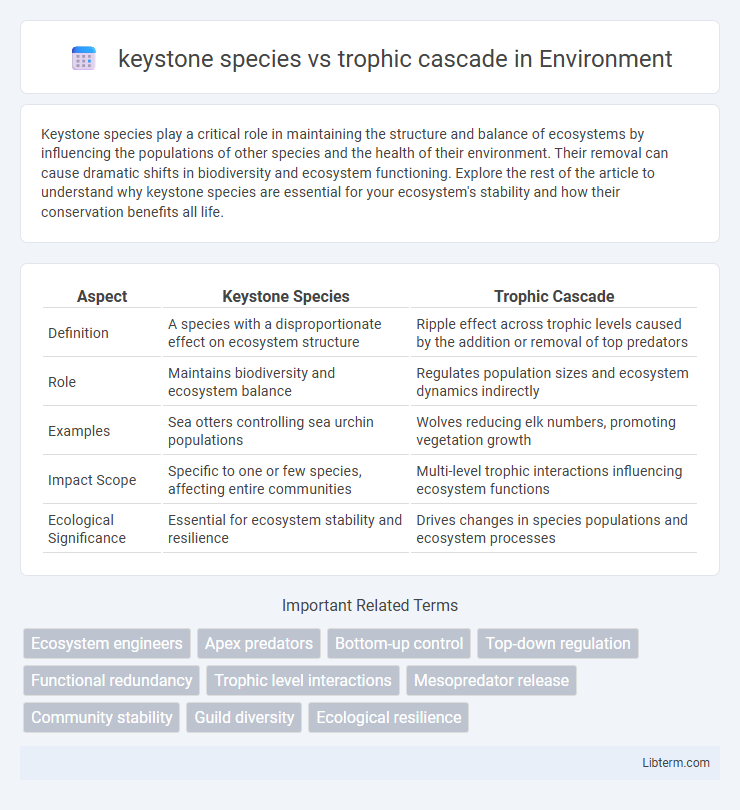Keystone species play a critical role in maintaining the structure and balance of ecosystems by influencing the populations of other species and the health of their environment. Their removal can cause dramatic shifts in biodiversity and ecosystem functioning. Explore the rest of the article to understand why keystone species are essential for your ecosystem's stability and how their conservation benefits all life.
Table of Comparison
| Aspect | Keystone Species | Trophic Cascade |
|---|---|---|
| Definition | A species with a disproportionate effect on ecosystem structure | Ripple effect across trophic levels caused by the addition or removal of top predators |
| Role | Maintains biodiversity and ecosystem balance | Regulates population sizes and ecosystem dynamics indirectly |
| Examples | Sea otters controlling sea urchin populations | Wolves reducing elk numbers, promoting vegetation growth |
| Impact Scope | Specific to one or few species, affecting entire communities | Multi-level trophic interactions influencing ecosystem functions |
| Ecological Significance | Essential for ecosystem stability and resilience | Drives changes in species populations and ecosystem processes |
Introduction to Keystone Species and Trophic Cascades
Keystone species are organisms that have a disproportionately large impact on their ecosystems relative to their abundance, often maintaining biodiversity and ecosystem structure. Trophic cascades describe the top-down effects that predators have on prey populations and vegetation, resulting in indirect consequences throughout multiple trophic levels. Understanding keystone species is crucial for studying trophic cascades, as the removal or addition of these species can trigger significant shifts in ecosystem dynamics.
Defining Keystone Species: Ecological Significance
Keystone species play a critical ecological role by maintaining the structure and balance of their ecosystems, often influencing multiple trophic levels far beyond their population size. Their presence or absence can trigger trophic cascades, leading to significant changes in species diversity and ecosystem functionality. Recognizing keystone species like wolves in Yellowstone or sea otters in kelp forests is essential for effective conservation and ecosystem management efforts.
Understanding Trophic Cascades in Ecosystems
Keystone species play a critical role in maintaining ecosystem stability by regulating population dynamics and preventing trophic cascades, which are dramatic changes in species abundance triggered by the removal or addition of top predators. Trophic cascades affect multiple trophic levels, influencing biodiversity, nutrient cycling, and habitat structure across ecosystems. Understanding the interaction between keystone species and trophic cascades provides insight into ecosystem resilience and informs conservation strategies to preserve ecological balance.
Key Differences: Keystone Species vs Trophic Cascade
Keystone species are organisms that have a disproportionately large impact on their ecosystem relative to their abundance, often maintaining the structure and diversity of their ecological community. Trophic cascades refer to the cascading effects that occur when predators suppress the abundance or alter the behavior of their prey, thereby affecting multiple lower trophic levels within a food web. The key difference lies in keystone species being individual species with critical ecological roles, while trophic cascades describe process-driven changes in ecosystem dynamics triggered by alterations in predator-prey interactions.
Keystone Species: Examples and Roles
Keystone species such as wolves in Yellowstone and sea otters in kelp forests play critical roles in maintaining ecosystem balance by directly regulating population sizes of other species, which prevents overgrazing and promotes biodiversity. Their presence influences trophic cascades, where changes at the top of the food chain ripple through lower trophic levels, dramatically altering ecosystem structure and function. Understanding keystone species aids in ecosystem management and conservation by highlighting species whose protection ensures stability and resilience across trophic interactions.
Trophic Cascade: Mechanisms and Examples
Trophic cascades occur when changes in the population of top predators trigger a series of effects that alter the abundance and distribution of species across multiple trophic levels, profoundly impacting ecosystem structure and function. Classic examples include the reintroduction of wolves in Yellowstone National Park, which controlled elk populations and allowed vegetation and other species to recover, demonstrating predator-driven regulation. These mechanisms underscore the critical role of predator-prey interactions in maintaining biodiversity and ecosystem resilience.
Interconnectedness: How Keystone Species Trigger Trophic Cascades
Keystone species maintain ecosystem stability by regulating populations of other organisms, preventing overgrazing or overpopulation. Their removal triggers trophic cascades, causing dramatic shifts in species abundance and resource availability across multiple trophic levels. These cascades highlight the complex interconnectedness within ecosystems, where changes in a single keystone species ripple through the food web, altering biodiversity and ecosystem function.
Case Studies: Real-World Ecological Impacts
The reintroduction of wolves in Yellowstone National Park exemplifies the keystone species concept by restoring balance and triggering a trophic cascade that curbed elk overgrazing and promoted vegetation recovery. In marine ecosystems, sea otters serve as keystone predators controlling sea urchin populations, preventing kelp forest degradation and supporting biodiversity. These case studies underscore how keystone species regulate trophic cascades, maintaining ecosystem health and stability across diverse habitats.
Conservation Implications of Keystone Species and Trophic Cascades
Keystone species play a critical role in maintaining ecosystem structure, and their removal can trigger trophic cascades that lead to significant biodiversity loss and habitat degradation. Conservation efforts targeting keystone species help stabilize food webs, prevent cascading extinctions, and preserve ecosystem functions such as nutrient cycling and primary productivity. Understanding trophic cascades is essential for developing management strategies that protect keystone species and promote ecosystem resilience in the face of environmental change.
Conclusion: The Future of Ecosystem Management
Effective ecosystem management increasingly recognizes the critical role of keystone species in maintaining biodiversity and ecosystem stability by preventing detrimental trophic cascades. Future conservation strategies prioritize protecting and restoring keystone species populations to ensure balanced trophic interactions, thereby sustaining ecosystem services and resilience. Integrating advanced monitoring technologies and ecological modeling will enhance adaptive management approaches, securing ecosystem health amid environmental change.
keystone species Infographic

 libterm.com
libterm.com